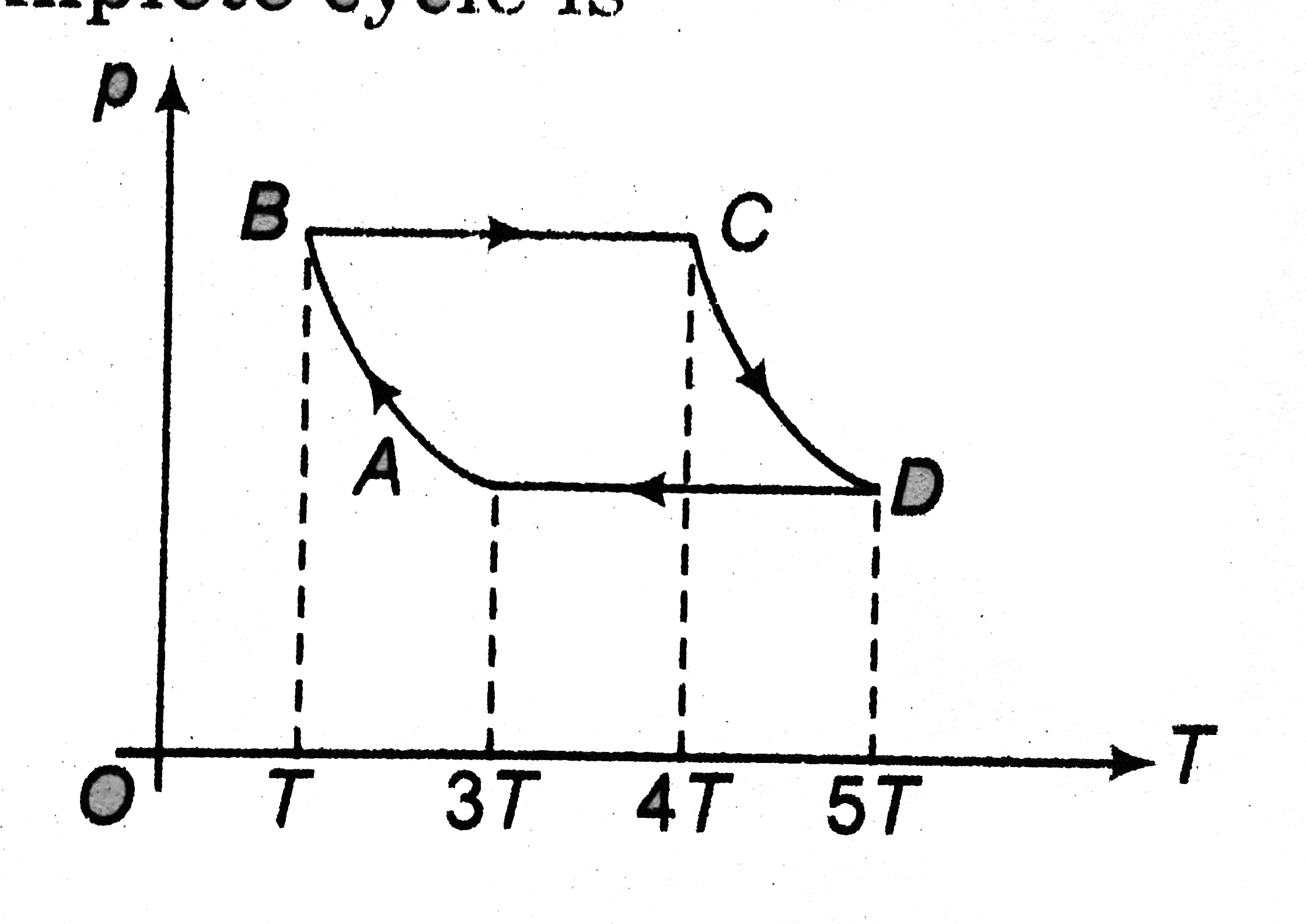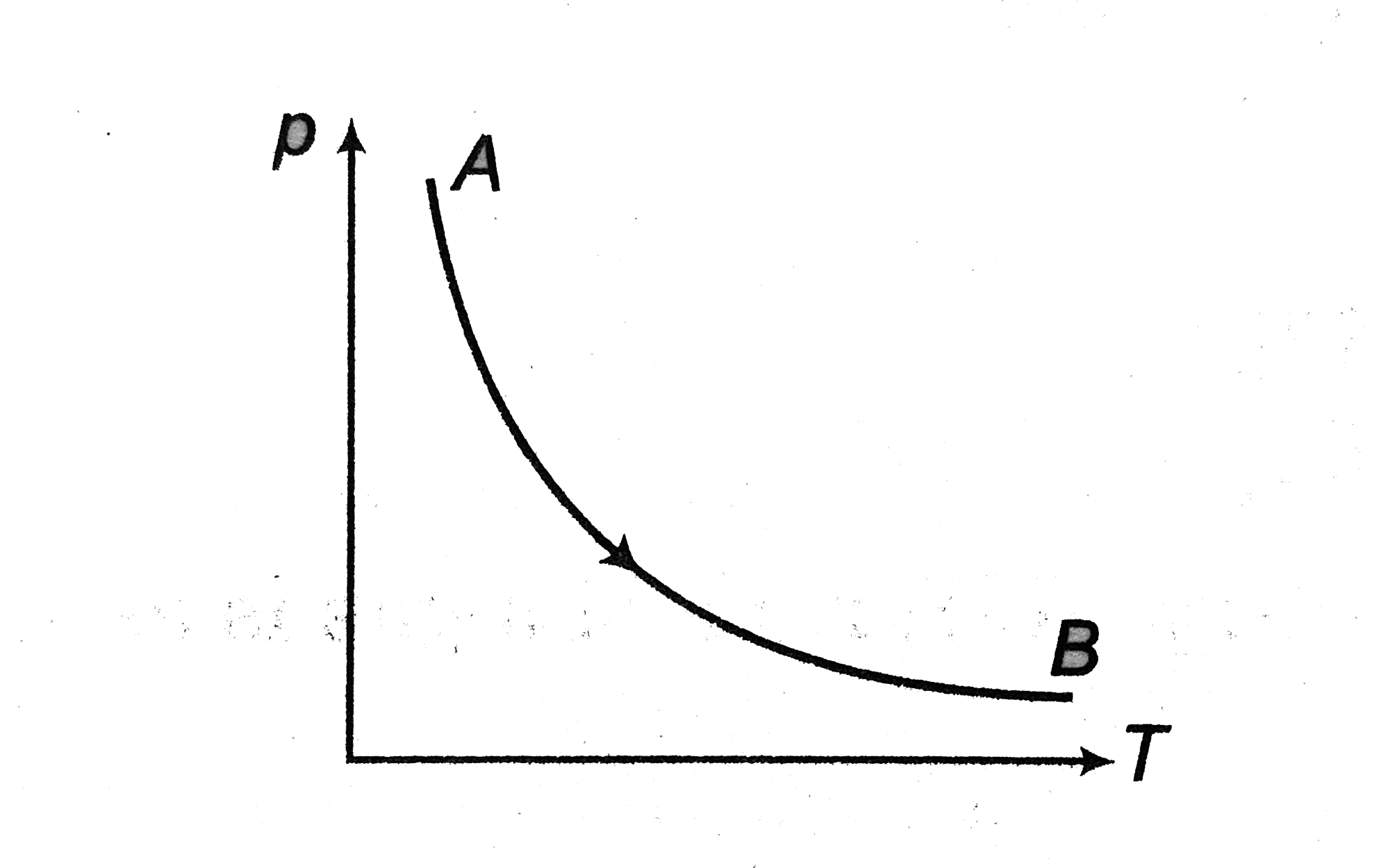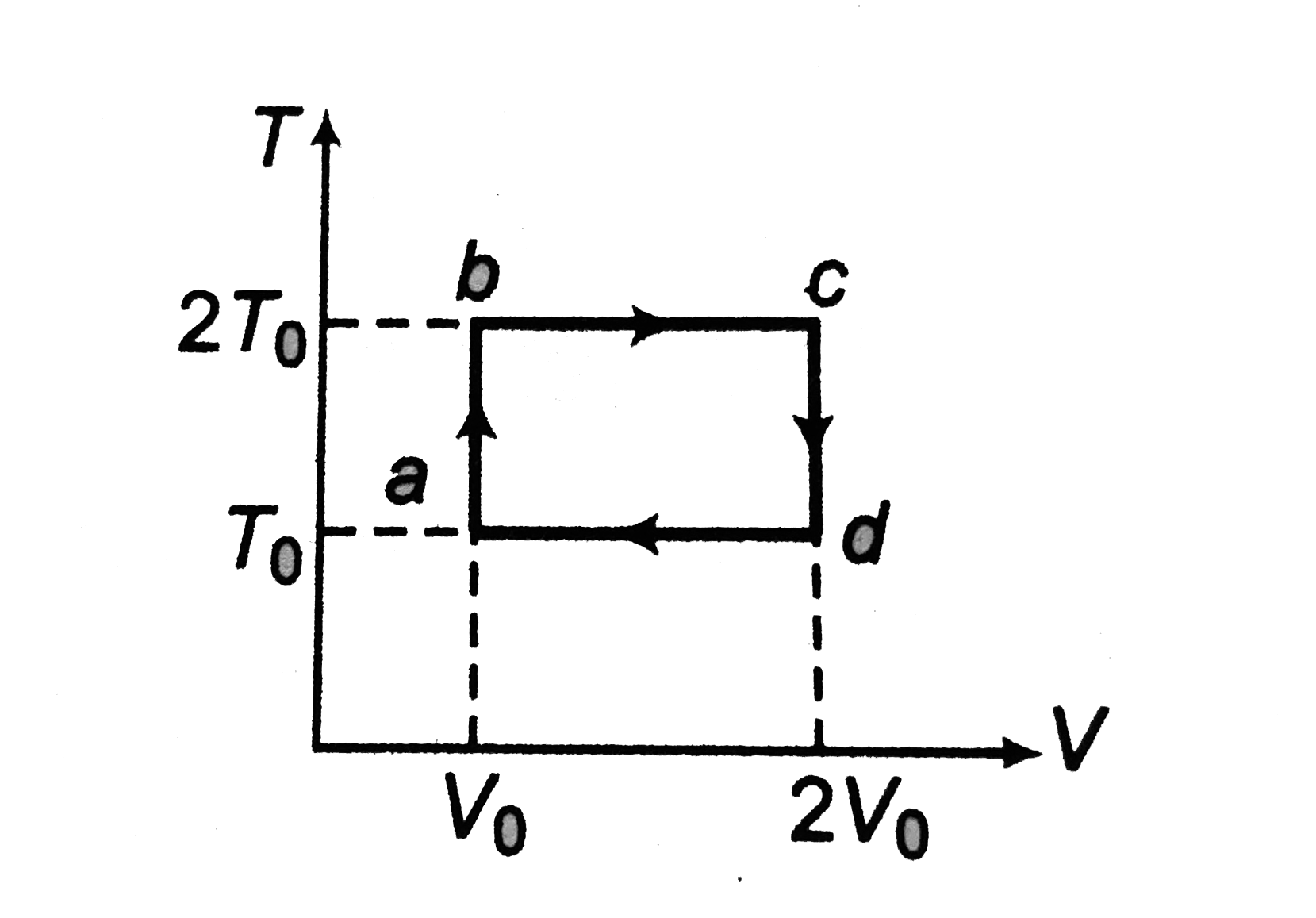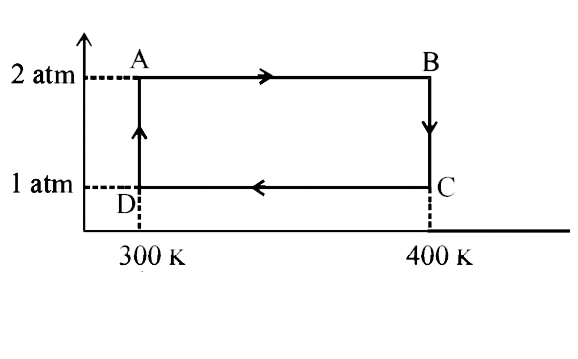Level 2 Single Correct from DC PANDEY ENGLISH LAWS OF THERMODYNAMICS for Class 11
| Class 11 | PHYSICS |
| Chapter | LAWS OF THERMODYNAMICS |
| DC PANDEY ENGLISH | Level 2 Single Correct |
| Medium | English |
| Academic Year | 2023-2024 |
Question 2
A gas in a cylinder is held at a constant pressure of 1.7×105Pa and is cooled and compressed from 1.20m3 to 0.8m3. The internal energy of the gas decreases by 1.1×105J.
(a) Find the work done by the gas.
(b) Find the magnitude of the heat flow into or out of the gas and state the direction of heat flow.
(c) Does it matter whether or not the gas is ideal?View SolutionQuestion 3
A thermodynamic system undergoes a cyclic process as shown in figure.
(a) over one complete cycle, does the system do positive or negative work.
(b) over one complete cycle, does heat flow into or out of the system.
(c) In each of the loops 1 and 2, does heat flow into or out of the system.
 View Solution
View SolutionQuestion 11
A well insulated box contains a partition dividing the box into two equal volumees as shown in figure. Initially, the left hand side contains an ideal monoatomic gas and the other half is a vacuum. The partition is suddenly removed so that the gas expands throughout the entire box.
(a) Does the temperature of gas change?
(b) Does the internal energy of the system change?
(c) Does the gas work?
 View Solution
View SolutionQuestion 23
n moles of a monoatomic gas are taken around in a cyclic process consisting of four processes along ABCDA as shown. All the lines on the p-V diagram have slope of magnitude p0/V0. The pressure at A and C is p0 and the volumes at A and C are V0/2 and 3V0/2, respectively. Calculate the percentage efficiency of the cycle.
 View Solution
View SolutionQuestion 51
A system is taken around the cycle shown in figure from state a to state b and then back to state a. The absolute value of the heat transfer during one cyle is 7200J. (a) Does the system absorb or liberate heat when it goes around the cycle in the direction shown in figure? (b) What is the work W done by the system in one cycle? (c) If the system goes around the cycle in a counter-clock wise direction, does it absorb or liberate heat in one cycle? What is the magnitude of the heat absorbed or liberated in one counter-clockwise cycle?
 View Solution
View SolutionQuestion 53
A thermodynamic system undergoes a cyclic process as shown in figure. The cycle consists of two closed loops, loop I and loop II. (a) Over one complete cycle, does the system do positive or negative work? (b) In each of loops I and II, is the net work done by the system positive or negative? (c) Over one complete cycle, does heat flow into or out of the system? (d) In each of loops I and II, does heat flow into or out of the system?
 View Solution
View SolutionQuestion 57
One mole of an ideal monatomic gas is taken round the cyclic process ABCA as shown in figure. Calculate
(a) the work done by the gas.
(b) the heat rejected by the gas in the path CA and the heat absorbed by the gas in the path AB,
(c) the net heat absorbed by the gas in the path BC,
(d) the maximum temperature attained by the gas during the cycle. View Solution
View SolutionQuestion 59
Two moles of a certain gas at a temperature T0=300K were cooled isochorically so that the pressure of the gas got reduced 2 times. Then as a result of isobaric process, the gas is allowed to expand till its temperature got back to the initial value. Find the total amount of heat absorbed by gas in this process.View SolutionQuestion 64
A gas in a cyclinder is held at a constant pressure of 2.30×105Pa and is cooled and compressed from 1.70m3 to 1.20m3. The internal energy of the gas decreases by 1.40×105J. (a) Find the work done by the gas. (b) Find the absolute value |Q| of the heat flow into or out of the gas and state the direction of the heat flow. (c) Does it matter whether or not the gas is ideal? Why or why not?View SolutionQuestion 65
p-V diagram of an ideal gas for a process ABC is as shown in the figure.
(a) Find total heat absorbed or released by the gas during the process ABC.
(b) Change in internal energy of the gas during the process ABC.
(c) Plot pressure versus density graph of the gas for the process ABC. View Solution
View SolutionQuestion 66
In the given graph, an ideal gas changes its state from A to C by two paths ABC and AC.
(a) Find the path along which work done is less.
(b) The internal energy of gas at A is 10J and the amount of heat supplied in path AC is 200J. Calculate the internal energy of gas at C.
(c) The internal energy of gas at state B is 20J. Find the amount of heat supplied to the gas to go from A to B. View Solution
View SolutionQuestion 67
When a gas expands along AB, it does 500J of work and absorbs 250 J of heat. When the gas expands along AC, it does 700J of work and absorbs 300J of heat.
(a) How much heat does the gas exchange along Bc?
(b) When the gas makes the transition from C to A along CDA, 800J of work are done on it from C to D. How much heat does it exchange along CDA?
 View Solution
View SolutionQuestion 69
One mole of an ideal monoatomic gas occupies a volume of 1.0×10−2m3 at a pressure of 2.0×105N/m2.
(a) What is the temperature of tha gas?
(b) The gas undergoes an adiabatic compression until its volume is decreased to 5.0×10−3m3. What is the new gas temperature?
(c) How much work is done on the gas during the compression?
(d) What is the change in the intenal energy of the gas?View SolutionQuestion 70
A bullet of mass 10g travelling horizontally at 200m/s strikes and embeds in a pendulum bob of mass 2.0 kg.
(a) How much mechanical energy is dissipated in the collision?
(b) Assuming that Cv for the bob plus bullet is 3R, calculate the temperature increase of the system due to the collision. Take the molecular mass of the system to be 200g/mol.View SolutionQuestion 72
An ideal gas is enclosed in a cyclinder with a movable piston on top. The piston has mass of 8000g and an area of 5.00cm2 and is free to slide up and down, keeping the pressure of the gas constant. How much work is done as the temperature of 0.200mol of the gas is raised from 200∘C to 300∘C?View SolutionQuestion 80
A monoatomic ideal gas, initially at temperature T1, is enclosed in a cylinder fitted with a friction less piston. The gas is allowed to expand adiabatically to a temperature T2 by releasing the piston suddenly. If L1andL2 are the length of the gas column before expansion respectively, then T1T2 is given byView SolutionQuestion 83
Two cylinders A and B fitted with pistons contain equal amounts of an ideal diatomic gas at 300K. The piston of A is free to move, while that B is held fixed. The same amount of heat is given to the gas in each cylinder. If the rise in temperature of the gas in A is 30K, then the rise in temperature of the gas in B is View SolutionQuestion 91
The given figure shows the variation of force applied by ideal gas on a piston which undergoes a process during which piston position changes from 0.1 to 0.4m. If the internal energy of the system at the end of the process is 2.5 J higher, then the heat absorbed during the process is
 View Solution
View SolutionQuestion 95
A gas takes part in two processes in which it is heated from the same initial state 1 to the same final temperature. The processes are shown on the p-V diagram by the straight lines 1-3 and 1-2. 2 and 3 are the points on the same isothermal curve. Q1 and Q2 are the heat transfer along the two processes. Then,
 View Solution
View SolutionQuestion 96
A closed system receives 200kJ of heat at constant volume. It then rejects 100kJ of heat while it has 50kJ of work done on it at constant pressure. If an adiabatic process can be found which will restore the system to its initial state, the work done by the system during this process isView SolutionQuestion 97
100 moles of an ideal monatomic gas undergoes the thermodynamic process as shown in the figure
A→B: isothermal expansion B→C: adiabatic expansion
C→D: isobaric compression D→A: isochoric process The heat transfer along the process AB is 9×104J. The net work done by the gas during the cycle is [Take R=8JK−1mol−1]
 View Solution
View SolutionQuestion 99
The state of an ideal gas is changed through an isothermal process at temperature T0 as shown in figure. The work done by the gas in going from state B to C is double the work done by gas in going from state A to B. If the pressure in the state B is p02, then the pressure of the gas in state C is
 View Solution
View SolutionQuestion 113
The density (ρ) versus pressure (p) graph of one mole of an ideal monoatomic gas undergoing a cyclic process is shown in figure. Molecular mass of gas is M.
(a) Find work done in each process.
(b) Find heat rejected by gas in one complete cycle.
(c) Find the efficiency of the cycle.
 View Solution
View SolutionQuestion 114
An ideal gas goes through the cycle abc. For the complete cycle 800J of heat flows out of the gas. Process ab is at constant pressure and process bc is at constant volume. In process c-a, p∝V. States a and b have temperature Ta=200K and Tb=300K. (a) Sketch the p-V diagram for the cycle. (b) What is the work done by the gas for the process ca?View SolutionQuestion 115
A cylinder of ideal gas is closed by an 8kg movable piston of area 60cm2. The atmospheric pressure is 100kPa. When the gas is heated form 30∘C to 100∘C, the piston rises 20 cm. The piston is then fastened in the place and the gas is cooled back to 30∘C. If ΔQ1 is the heat added to the gas during heating and ΔQ2 is the heat lost during cooling, find the difference.View SolutionQuestion 116
Three moles of an ideal gas (Cp=72R) at pressure p0 and temperature T0 is isothermally expanded to twice its initial volume. It is then compressed at a constant pressure to its original volume.
(a) Sketch p-V and p-T diagram for complete process.
(b) Calculate net work done by the gas.
(c) Calculate net heat supplied to the gas during complete process.
(Write your answer in terms of gas constant =R)View SolutionQuestion 117
Two moles of helium gas(λ=5/3) are initially at temperature 27∘C and occupy a volume of 20 litres. The gas is first expanded at constant pressure until the volume is doubled. Then it undergoes an adiabatic change until the temperature returns to its initial value.
(i) Sketch the process on a p-V diagram.
(ii) What are the final volume and pressure of the gas?
(iii) What is the work done by the gas ?View SolutionQuestion 118
An ideal monoatomic gas is confined in a cylinder by a spring-loaded piston of cross-section 8.0×10−3m2. Initially the gas is at 300K and occupies a volume of 2.4×10−3m3 and the spring is in its relaxed (unstretched, unompressed) state, fig. The gas is heated by a small electric heater until the piston moves out slowly by 0.1m. Calculate the final temperature of the gas and the heat supplied (in joules) by the heater. The force constant of the spring is 8000N/m, atmospheric pressure is 1.0×105Nm−2. The cylinder and the piston are thermally insulated. The piston is massless and there is no friction between the piston and the cylinder. Neglect heat loss through lead wires of the heater. The heat capacity of the heater coil is negligible. Assume the spring to be massless.
 View Solution
View SolutionQuestion 122
One mole of a gas is put under a weightless piston of a vertical cylinder at temperature T. The space over the piston opens into atmosphere. Initially, piston was in equilibrium. How much work should be performed by some external force to increase isothermally the volume under the piston to twice the volume? (Neglect friction of piston).View SolutionQuestion 127
An ideal gas has a specific heat at constant pressure Cp=5R2. The gas is kept in a closed vessel of volume V0 at temperature T0 and pressure p0. An amount fo 10p0V0 of heat is supplied to the gas.
(a) Calculate the final pressure and temperature of the gas.
(b) Show the process on p-V diagram.View SolutionQuestion 128
Three moles of an ideal gas being initially at a temperature Ti=273K were isothermally expanded 5 times its initial volume and then isochorically heated so that the pressure in the final state becomes equal to that in the initial state. The total heat supplied in the process is 80kJ. Find γ(=CpCV) of the gas.View Solution
All Exercises from DC PANDEY ENGLISH Class 11 PHYSICS LAWS OF THERMODYNAMICS
- EXERCISE 21.1
- EXERCISE 21.2
- EXERCISE 21.3
- EXERCISE 21.4
- LEVEL 1 ASSERTION AND REASON
- LEVEL 1 OBJECTIVE
- LEVEL 1 OBJECTIVE QUESTIONS
- LEVEL 1 SUBJECTIVE
- LEVEL 2 MORE THAN ONE CORRECT
- LEVEL 2 PASSAGE I
- LEVEL 2 PASSAGE II
- LEVEL 2 SINGLE CORRECT
- LEVEL 2 SUBJECTIVE
- EXAMPLE
- EXAMPLE TYPE 1
- EXAMPLE TYPE 2
- EXAMPLE TYPE 3
- MISCELLANEOUS EXAMPLE
































